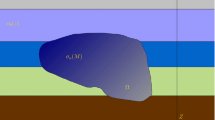Abstract
A new efficient parallel finite-difference time-domain (FDTD) meshing algorithm, based on the ray tracing technique, is proposed in this paper. This algorithm can be applied to construct various FDTD meshes, such as regular and conformal ones. The Microsoft F# language is used for the algorithm coding, where all variables are unchangeable with its parallelization advantage being fully exploited. An improved conformal FDTD algorithm, also integrated with an improved surface current algorithm, is presented to simulate some complex 3D models, such as a sphere ball made of eight different materials, a tank, a J-10 aircraft, and an aircraft carrier with 20 aircrafts. Both efficiency and capability of the developed parallel FDTD algorithm are validated. The algorithm is applied to characterize the induced surface current distribution on an aircraft or a warship.
Similar content being viewed by others
References
Benkler, S., Chavannes, N., Kuster, N., 2008. Mastering conformal meshing for complex CAD-based C-FDTD simulations. IEEE Antennas Propag. Mag., 50(2):45–57. [doi:10.1109/MAP.2008.4562256]
Flubacher, R., Luebbers, R., 2003. FDTD mesh generation using computer graphics technology. IEEE Antennas and Propagation Society Int. Symp., p.333–336. [doi:10.1109/APS.2003.1217464]
Guiffaut, C., Mahdjoubi, K., 2001. A parallel FDTD algorithm using the MPI library. IEEE Antennas Propag. Mag., 43(2):94–103. [doi:10.1109/74.924608]
Hadi, M.F., Mahmoud, S.F., 2007. Optimizing the compact-FDTD algorithm for electrically large wave-guiding structures. Prog. Electromagn. Res., 75:253–269. [doi:10. 2528/PIER07060703]
Hill, J., 1996. Efficient Implementation of Mesh Generation and FDTD Simulation of Electromagnetic Fields. MS Thesis, Worcester Polytechnic Institute, MA, USA.
Hsu, H.T., Kuo, F.Y., Chou, H.T., 2009. Convergence study of current sampling profiles for antenna design in the presence of electrically large and complex platforms using FIT-UTD hybridization approach. Prog. Electromagn. Res., 99:195–209. [doi:10.2528/PIER09092404]
Juntunen, J.S., Tsiboukis, T.D., 2000. Reduction of numerical dispersion in FDTD method through artificial anisotropy. IEEE Trans. Microw. Theory Tech., 48(4):582–588. [doi:10.1109/22.842030]
Kim, J., Teixeira, F.L., 2011. Parallel and explicit finite-element time-domain method for Maxwell’s equations. IEEE Trans. Antennas Propag., 59(6):2350–2356. [doi:10. 1109/TAP.2011.2143682]
Kong, L.Y., Wang, J., Yin, W.Y., 2012. A novel dielectric conformal FDTD method for computing SAR distribution of the human body in a metallic cabin illuminated by an intentional electromagnetic pulse (IEMP). Prog. Electromagn. Res., 126:355–373. [doi:10.2528/PIER11112702]
Lei, J.Z., Liang, C.H., Ding, W., et al., 2008. EMC analysis of antennas mounted on electrically large platforms with parallel FDTD method. Prog. Electromagn. Res., 84:205–220. [doi:10.2528/PIER08071303]
Shan, X., Guan, S., Liu, Z., et al., 2013. A new energy harvester using a piezoelectric and suspension electromagnetic mechanism. J. Zhejiang Univ.-Sci. A (Appl. Phys. & Eng.), 14(12):890–897. [doi:10.1631/jzus.A1300210]
Srisukh, Y., Nehrbass, J., Teixeira, F.L., et al., 2002. An approach for automatic grid generation in three-dimensional FDTD simulations of complex geometries. IEEE Antennas Propag. Mag., 44(4):75–80. [doi:10.1109/MAP.2002.1043151]
Taflove, A., Hagness, S.C., 2000. Computational Electrodynamics: the Finite-Difference Time-Domain Method (2nd Ed.). Artech House, Norwood, MA, USA.
Vaccari, A., Lesina, A.C., Cristoforetti, L., et al., 2011. Parallel implementation of a 3D subgridding FDTD algorithm for large simulations. Prog. Electromagn. Res., 120:263–292.
Wang, H., Tang, L., Guo, Y., et al., 2014. A 2DOF hybrid energy harvester based on combined piezoelectric and electromagnetic conversion mechanisms. J. Zhejiang Univ.-Sci. A (Appl. Phys. & Eng.), 15(9):711–722. [doi:10. 1631/jzus.A1400124]
Wang, J., Yin, W.Y., 2013. Development of a novel FDTD (2, 4)-compatible conformal scheme for electromagnetic computations of complex curved PEC objects. IEEE Trans. Antennas Propag., 61(1):299–309. [doi:10.1109/TAP.2012.2216851]
Xiong, R., Chen, B., Han, J.J., et al., 2012. Transient resistance analysis of large grounding systems using the FDTD method. Prog. Electromagn. Res., 132:159–175. [doi:10. 2528/PIER12082601]
Yang, M., Chen, Y., 1999. AutoMesh: an automatically adjustable, nonuniform, orthogonal FDTD mesh generator. IEEE Antennas Propag. Mag., 41(2):13–19. [doi:10.1109/74.769687]
Yu, W.H., Mittra, R., 2000. A conformal FDTD software package modeling antennas and microstrip circuit components. IEEE Antennas Propag. Mag., 42(5):28–39. [doi:10.1109/74.883505]
Author information
Authors and Affiliations
Corresponding author
Additional information
Project supported in part by the National Natural Science Foundation of China (No. 60831002) and Zhejiang Provincial Natural Science Foundation of China (No. LZF010001)
ORCID: Yang GUO, http://orcid.org/0000-0002-5681-0606
Rights and permissions
About this article
Cite this article
Guo, Y., Wang, Xh. & Hu, J. A new parallel meshing technique integrated into the conformal FDTD method for solving complex electromagnetic problems. J. Zhejiang Univ. - Sci. C 15, 1087–1097 (2014). https://doi.org/10.1631/jzus.C1400135
Received:
Accepted:
Published:
Issue Date:
DOI: https://doi.org/10.1631/jzus.C1400135




